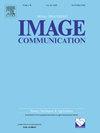利用深度神经网络获得的伪边缘区域分割人类牙齿图像中的单个牙齿
IF 3.4
3区 工程技术
Q2 ENGINEERING, ELECTRICAL & ELECTRONIC
引用次数: 0
摘要
在普通光学相机拍摄的口腔外的人类牙齿图像中,由于常见的边缘弱、强度不均匀和强光反射等障碍,难以分割单个牙齿。在这项工作中,我们提出了一种人类牙齿图像中单个牙齿的分割方法。该方法的关键是利用深度神经网络获得伪边缘区域。在获得每个牙齿区域的初始轮廓后,通过应用活动轮廓模型对单个牙齿进行分割。我们还提出了一种策略,使用现有的基于模型的方法来标记神经网络训练所需的数据。本文章由计算机程序翻译,如有差异,请以英文原文为准。
Individual tooth segmentation in human teeth images using pseudo edge-region obtained by deep neural networks
In human teeth images taken outside the oral cavity with a general optical camera, it is difficult to segment individual tooth due to common obstacles such as weak edges, intensity inhomogeneities and strong light reflections. In this work, we propose a method for segmenting individual tooth in human teeth images. The key to this method is to obtain pseudo edge-region using deep neural networks. After an additional step to obtain initial contours for each tooth region, the individual tooth is segmented by applying active contour models. We also present a strategy using existing model-based methods for labeling the data required for neural network training.
求助全文
通过发布文献求助,成功后即可免费获取论文全文。
去求助
来源期刊

Signal Processing-Image Communication
工程技术-工程:电子与电气
CiteScore
8.40
自引率
2.90%
发文量
138
审稿时长
5.2 months
期刊介绍:
Signal Processing: Image Communication is an international journal for the development of the theory and practice of image communication. Its primary objectives are the following:
To present a forum for the advancement of theory and practice of image communication.
To stimulate cross-fertilization between areas similar in nature which have traditionally been separated, for example, various aspects of visual communications and information systems.
To contribute to a rapid information exchange between the industrial and academic environments.
The editorial policy and the technical content of the journal are the responsibility of the Editor-in-Chief, the Area Editors and the Advisory Editors. The Journal is self-supporting from subscription income and contains a minimum amount of advertisements. Advertisements are subject to the prior approval of the Editor-in-Chief. The journal welcomes contributions from every country in the world.
Signal Processing: Image Communication publishes articles relating to aspects of the design, implementation and use of image communication systems. The journal features original research work, tutorial and review articles, and accounts of practical developments.
Subjects of interest include image/video coding, 3D video representations and compression, 3D graphics and animation compression, HDTV and 3DTV systems, video adaptation, video over IP, peer-to-peer video networking, interactive visual communication, multi-user video conferencing, wireless video broadcasting and communication, visual surveillance, 2D and 3D image/video quality measures, pre/post processing, video restoration and super-resolution, multi-camera video analysis, motion analysis, content-based image/video indexing and retrieval, face and gesture processing, video synthesis, 2D and 3D image/video acquisition and display technologies, architectures for image/video processing and communication.
 求助内容:
求助内容: 应助结果提醒方式:
应助结果提醒方式:


